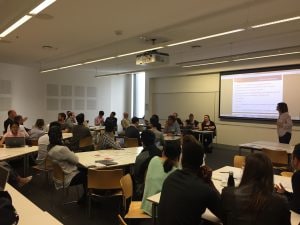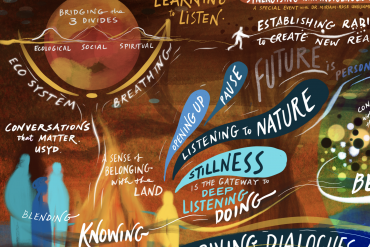How would you design a lecture that would achieve 100% attendance and engagement? What would make a lecture ‘unmissable’? That was the challenge set for a group of staff and students, at the inaugural Hack Your Lecture 2018 event, hosted by the Educational Innovation team on 3 October. Over 90 minutes, an expert panel of University academics shared their thoughts on the perfect lecture, then the audience worked in teams to hack a number of existing lectures and brainstorm ways to transform them into ideal learning experience. We summarise the advice from the panel of seasoned academics and review some of the most impressive lecture hacks suggested.
This article has been expanded from the Staff News article with permission. The Hack Your Lecture event was based on a similar event ‘Mission: Impossible – Designing the Ideal Lecture’ from the University of Edinburgh.
Advice from the experts: it’s all about the student
Professor Rick Benitez (Philosophy), Associate Professor Rebekah Moles (Pharmacy), Professor Dirk Moses (Modern History) and Dr Vanessa Olsen (Nursing) formed the panel to share their thoughts on an effective lecture in 2018, as well as their advice to new lecturers.
Vanessa
“We can no longer stand in front of a room with students and talk for hours with slides”
- Make lectures interactive – build in questions and discussions, especially to unpack misconceptions
- Make it fun and engaging – and be especially excited about parts that you know students have difficulty with
- Cut content from your slides – if you want deep learning, you need to take content out: try put content in an online pre-module, and during class apply the content to something practical and relevant such as a case study
- Increase relevance – help students see the connection between class content and their future practice
- Love what you do – it will help your students fall in love with your subject too
- Find someone who has good lectures and watch how they teach. Find mentors. See what works and what doesn’t work.
Rick
Rick started by asking, is there even such a thing as a perfect lecture? He considered every lecture to be context-specific – given to specific people on a specific topic in a specific place. He also thought of lectures as jazz music, in that improvisation was key and that canned lectures are not perfect lectures.
“I think of lecturing a little bit like jazz music and improvisation is crucial in making a lecture work.”
- Take a risk – and be persistent in trying new things. Don’t be dispirited by something you try and doesn’t seem to work.
- Use your imagination – don’t force yourself to use the examples, analogies, and jokes you’ve prepared. If you know of something on the spot that you know will work, use that.
- Listen to your class – listen to their laptops, body language, rustling. What are your students doing? Be more responsive. Engage with them and they’ll engage with you.
- Often, lecturers wanting to be more confident breeds a tendency to overprepare and fill up slides with words, make longer lectures, and not allow for interruptions. To this, of which we are all guilty, Rick suggests: “just keep it simple!“
Dirk
- Attention spans have changed – when he sees students tuning out, he stops content delivery and walks into the aisles. “Like Oprah”. Dirk then starts a discussion, turning the lecture into a seminar, getting students to take reponsibility for their learning. But he’s noticed that some students have stopped coming to lectures because they were terrified of speaking in class (even though Dirk doesn’t force anyone to speak, the expectation terrified his students!)
- Recognise that each student has a right to learn in their own way, through their own process.
- Add humour wherever you can – it shows that you’re human and not an automaton or a parent figure. Be spontaneous.
Rebekah
- Students need to be engaged – tell them about important things (what’s assessable, but not just that) and change up the scenery
- Relevance often gets lost in the content – involve case studies to help make the content mean something instead of just learning disconnected facts
Hacks of the day

The tables of lecture hackers presented their hacks to everyone. Here are the key takeaways.
- Work on design elements – include human pictures and connections, intersperse text with meaningful visuals.
- Have a common narrative that goes throughout the lecture and use this to motivate students. Link this in with the lecture’s learning outcomes.
- For example, in the hacked lecture which was about calculating risk and constructing an argument, the hackers recommended to start the lecture with a ‘why this matters’ big question, then move the masses of key terms all on one slide as a reference, followed by a class discussion on how risk is perceived by people (since students should have an intuitive sense of this), and then launching into the heavier theory once their interest is piqued, followed finally by an activity where students need to apply what they have just learnt and calculate risk and construct an argument around this.
- Many lectures had far too much content for an hour. Some suggestions from the lecture hackers:
- Use PowerPoint animations judiciously so that diagrams and other content appear in order alongside verbal explanations.
- Intersperse content with quizzes or other activities that let you better you understand what students are thinking, and get them to explain concepts in their own words. This could be in the form of quizzes, or Padlet activities, or online whiteboards for drawing – where students can safely contribute thoughts, questions, and images while collaboratively viewing and responding to peers.
- For more conceptual subjects, put up a model or framework near the beginning and keep referring back to this during the lecture. This ‘advance organiser‘ helps students to better situate and contextualise new knowledge.
- Don’t be afraid to break students out of their comfort zone (of being ‘lectured at’) and get them used to new teaching style – this advice from an international student!
- More advice from students: Think of lecture as a product that you’re trying to sell to students. We ask students to make presentations that are clear and engaging (and even grade them on this!) but do we do this for our lectures?
- Move the more difficult content to the beginning so that students are ‘fresher’, and/or create online videos where you work through and talk about problems and apply concepts.
- Consider whether your lecture contains fundamentals that students should already know – if so, pop these onto Canvas as supplemental readings or video recordings.
And the verdict?
I would like to think of new and specific ways to increase engagement not necessarily just participation.
Overall the room was buzzing with enthusiasm about the prospect of hacking lectures across the university to improve student learning. 100% of survey respondents said that they were satisfied with the event and could see themselves applying things to their own teaching. These ranged from “throw away my slides” to less drastic measures like “[I] like the idea of leaving more gaps, ensuring not to over prepare, and listen to the room” and “reduce content in lectures, more flipped classrooms, weave story arc into class”. One anonymous respondent noted, “I would try to incorporate clearer narratives, emotional engagement elements, less confronting ways for students to participate (e.g. socrative) into my lectures. I would like to think of new and specific ways to increase engagement not necessarily just participation.”
Tell me more
- Check out the articles here on Teaching@Sydney on effective lectures, such as Chunking your class – lessons we learnt from observing other lecturers, Building Effective Interactive Polls for Lectures, Bringing the world into your lecture, and the small changes you can make that have big impacts on students.
- Times Higher Education recently ran a piece summarising advice from eight academics: Top tips on how to make your lectures interesting.
- Watch the full recording of the session.





